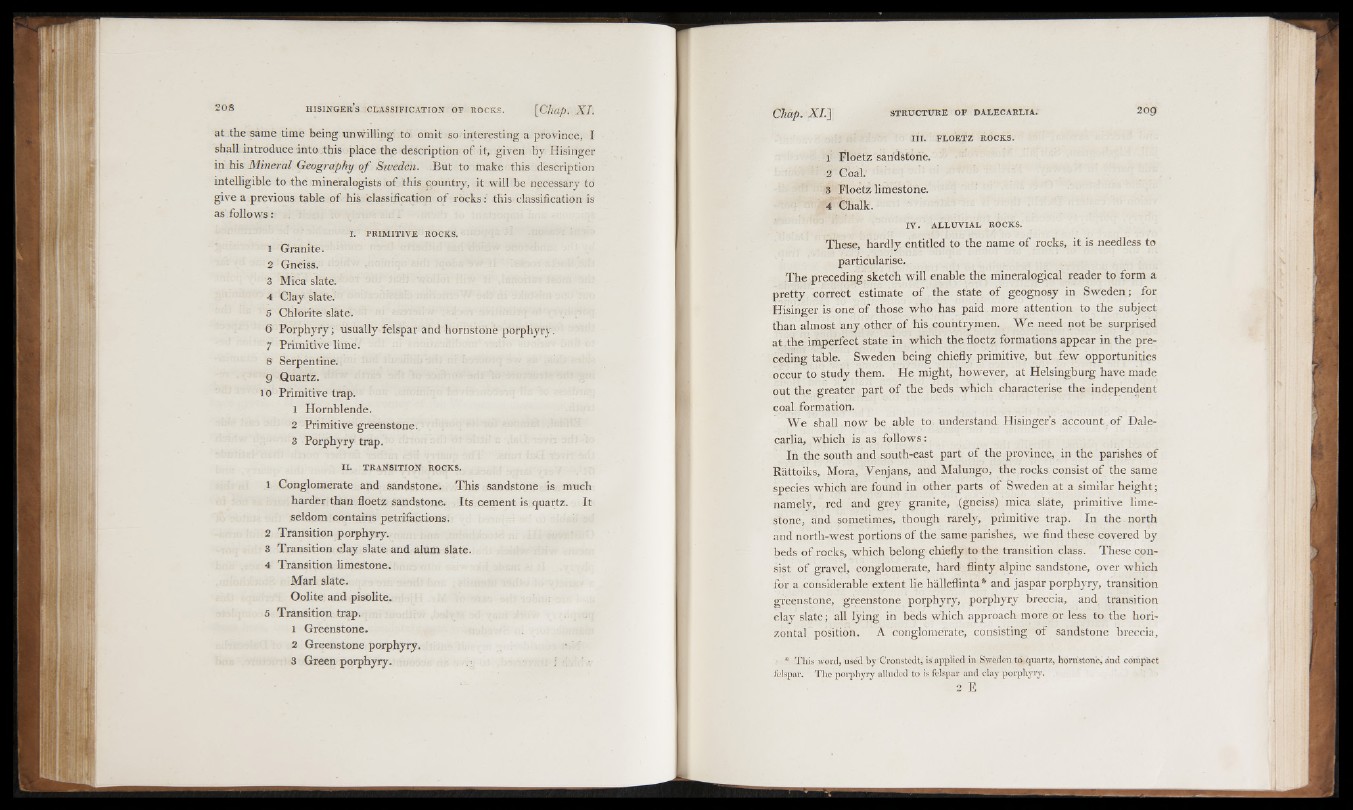
at the same time being unwilling to omit so interesting a province, I
shall introduce into this place the description of it, given by Hisinger
in his Mineral Geography o f Sweden. But to make this description
intelligible to the mineralogists of this pountry, it will be necessary to
give a previous table o f his classification of rocks: this classification is
as follows:
I. PRIMITIVE ROCKS.
1 Granite.
2 Gneiss.
3 Mica slate.
4 Clay slate.
5 Chlorite slate.
6 Porphyry; usually felspar and hornstone porphyry.
7 Primitive lime.
8 Serpentine.
9 Quartz.
10 Primitive trap.
1 Hornblende.
2 Primitive greenstone.
3 Porphyry trap.
IL TRANSITION ROCKS.
1 Conglomerate and sandstone. This sandstone is much
harder than floetz sandstone. Its cement is quartz. It
seldom contains petrifactions.
2 Transition porphyry.
3 Transition clay slate and alum slate.
4 Transition limestone.
Marl slate.
Oolite and pisolite.
5 Transition trap.
1 Greenstone.
2 Greenstone porphyry.
3 Green porphyry.
I II . FLOETZ ROCKS.
1 Floetz sandstone.
2 Coal.
3 Floetz limestone.
4 Chalk.
IV . A L LU V IA L ROCKS.
These, hardly entitled to the name o f rocks, it is needless to
particularise.
The preceding sketch will enable the mineralogical reader to form a
pretty correfct estimate o f the state o f geognosy in Sweden; for
Hisinger is one o f those who has paid, more attention to the subject
than almost any other o f his. countrymen. W e need not be surprised
at .the imperfect state in which the floetz formations appear in the preceding
table. Sweden being chiefly primitive, but few opportunities
occur to study them. He might, however, at Helsingburg have made
out the greater part o f the beds which characterise the independent
coal, formation.
W e shall now be able to understand Hisinger s account , o f Dale-
carlia, which is as follows:
In the south and south-east part of the province, in the parishes of
Rattoiks, Mora, Yenjans, and Malungo, the rocks consist of the same
species which are found in other parts of Sweden at a similar height;
namely, red and grey granite, .(gneiss) mica slate, primitive limestone,
and sometimes, though rarely, primitive trap. In the north
and north-west portions o f the same parishes, we find these covered by
beds o f rocks, which belong chiefly to the transition class. These consist
of gravel, conglomerate, hard flinty alpine sandstone, over which
for a considerable extent lie halleflinta* and jaspar porphyry, transition
greenstone, greenstone porphyry, porphyry breccia, and transition
clay slate; all lying in beds which approach more or less to the hori-
zontar position. A conglomerate, consisting of sandstone hreccia,
• * This word, used by Cronstedt, is'applied in Sweden to quartz, hornstone, and compact
felspar. The porphyry alluded to is felspar and clay porphyry.